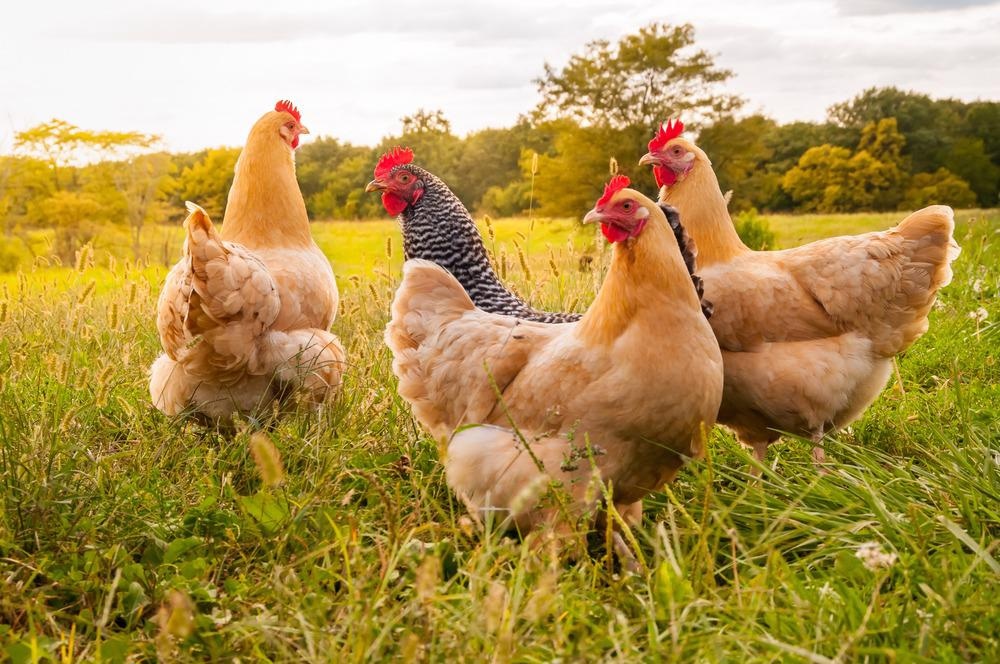A paper available as a pre-proof in the journal Livestock Science demonstrates the effectiveness of using nano-ferrous sulfate (N-FeS) to improve the iron (Fe) absorption rates in broiler chickens.

Study: Enhancement of ferrous sulfate absorption using nano-technology in broiler chickens. Image Credit: Moonborne/Shutterstock.com
Iron Supplements in the Poultry Industry
Iron is an essential element for broiler chickens as it is crucial for neurotransmitter synthesis and energy metabolism. Typically, 20 mg/kg Fe supplementation is recommended for broiler chickens. Inorganic Fe salts are most commonly used as dietary iron supplements.
In the poultry industry, however, inorganic Fe levels often surpass recommended amounts to ensure the growth requirement of chickens. The excessive supplementation of inorganic Fe content results in high excretion into the environment through feces, which can be dangerous pollutants.
Hot-melt extrusion (HME) processing is a highly effective procedure for the development of molecular dispersions of active pharmaceutical ingredients in different surfactants and polymers. The particle size of the ingredients is reduced using surfactants such as tween 80 and span 80 through the HME process.
The procedure can help in improving the dispersion uniformity and bioavailability of water-insoluble nanoparticles and enhance their absorption through enterocytes.
Similar modifications can potentially decrease the supplementation content and improve the bioavailability of Fe in animal diet, thereby reducing the excretion of Fe through feces and the resultant environmental pollution.
In this study, researchers synthesized N-FeS through the HME process and evaluated the effect of N-FeS on intestinal morphology and microflora, nutrient digestibility, fecal excretion, absorption, and growth performance of Fe in broiler chickens.
Assessing Optimal Fe Nanoparticle Levels
Polyethylene glycol 6000, tween 80, span 80, and FeS were mixed at the ratio of 64:4:12:20, and the mixture was placed to a feed hopper at a speed of 45 g/min.
A hot-melt extruder connected to a round-shaped die was used with a twin-screw system to prepare extruded materials at 60oC and 55oC temperatures at the die and barrel section, respectively.
During the HME process, the screw speed was maintained at 150 rpm, and the particles were subsequently extruded from the die, conveying, and kneading sections through the barrel. Eventually, the extruded products were solidified and then milled using a grinder.
Laser Doppler methods, dynamic light scattering, and transmission electron microscopy (TEM) were employed to characterize the synthesized N-FeS.
Inductively coupled plasma (ICP) emission spectroscopy was used to investigate the iron content in liver, serum, excreta, and feed in triplicates on dissolved ashes according to the Association of Official Analytical Collaboration (AOAC) 2007.
Two experiments were performed to measure the Fe nanoparticle absorption ratio and to assess the optimal concentrations of dietary Fe in broiler chickens.
In the first experiment, three dietary treatments were assigned randomly to 36 21-day-old broiler chickens, where 12 broiler chickens were housed individually per treatment in order to assess the iron absorption rates in organic Fe/ferrous methionine (FeM), N-FeS, and FeS form of supplements.
In the second experiment, eight dietary treatments were allotted randomly to 720 one-day-old broiler chickens, which included four concentrations of 30, 20, 10, and 5 ppm and two sources of N-FeS and FeS based on a 2 × 4 factorial arrangement.
The second study aimed to evaluate the Fe intestinal microbiota, intestinal integrity, nutrient digestibility, growth performance, and absorption. All diets were provided in two phases in a mash form. The first phase was 0-14 days, and the second phase was 14-35 days.
Tukey’s Honestly Significant Difference test was employed to evaluate the notable difference in the Fe treatment forms, while the GLM procedure of SAS was used to perform statistical analysis of the obtained data.
Research Findings
N-FeS was synthesized successfully through the HME process. The average particle size in the synthesized N-FeS was 342 ± 46 nm.
In the first experiment, the Fe content in excreta was reduced when the chickens were fed with FeM and N-FeS in place of FeS. The standardized total tract digestibility, apparent total tract digestibility, and absorption rate were increased in the N-FeS and FeM treatment compared with the FeS.
In the second experiment, the digestibility of crude protein, hemoglobin concentration, and red blood cell (RBC) concentration was increased linearly corresponding with the increase in the dietary Fe concentration.
A notably higher RBC count was observed in broiler chickens when they were fed with N-FeS compared to FeS. In phase one, Fe concentration in serum was increased with N-FeS treatments compared to FeS treatments. However, no such change was observed in the second phase.
Fe content in excreta increased linearly when the chickens were fed with either N-FeS or FeS diets. However, the total Fe excretion was less in N-FeS treatment compared to FeS treatment.
In the liver, Fe concentration increased in both N-FeS and FeS treatment. No effect of Fe supplementation was observed on the growth performance of the broiler chickens.
Taken together, the findings of this study demonstrated that N-FeS supplementation is more efficient than common FeS as N-FeS improved Fe absorption rates, increased Fe concentration in serum and liver, and reduced Fe in excreta.
Reference
K.Y. Kim., J.H. Lee., A. Hosseindoust. et al. (2022) Enhancement of ferrous sulfate absorption using nano-technology in broiler chickens. Livestock Science https://www.sciencedirect.com/science/article/pii/S187114132200049X
Disclaimer: The views expressed here are those of the author expressed in their private capacity and do not necessarily represent the views of AZoM.com Limited T/A AZoNetwork the owner and operator of this website. This disclaimer forms part of the Terms and conditions of use of this website.